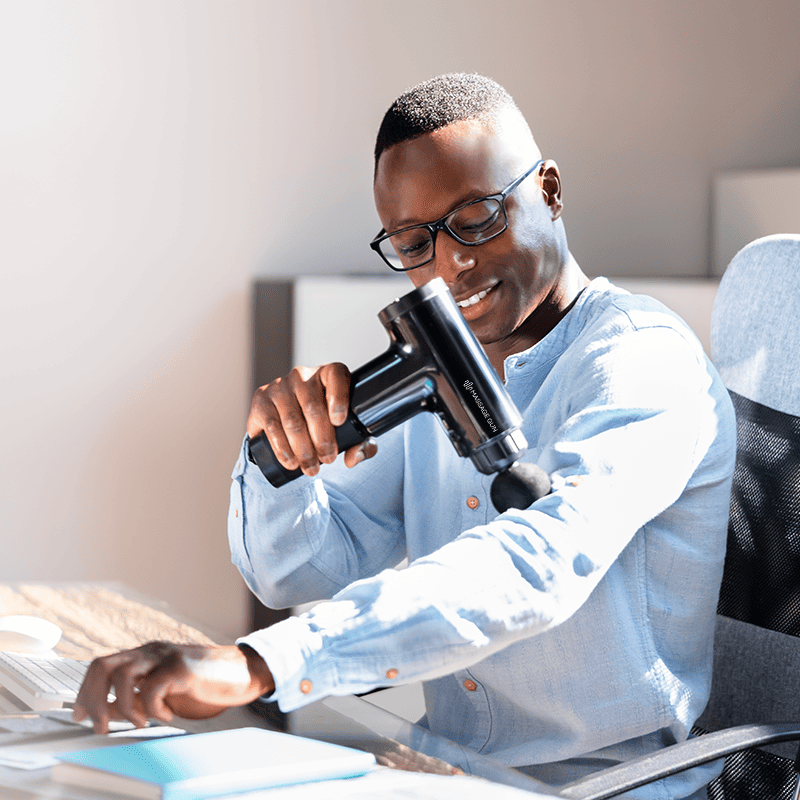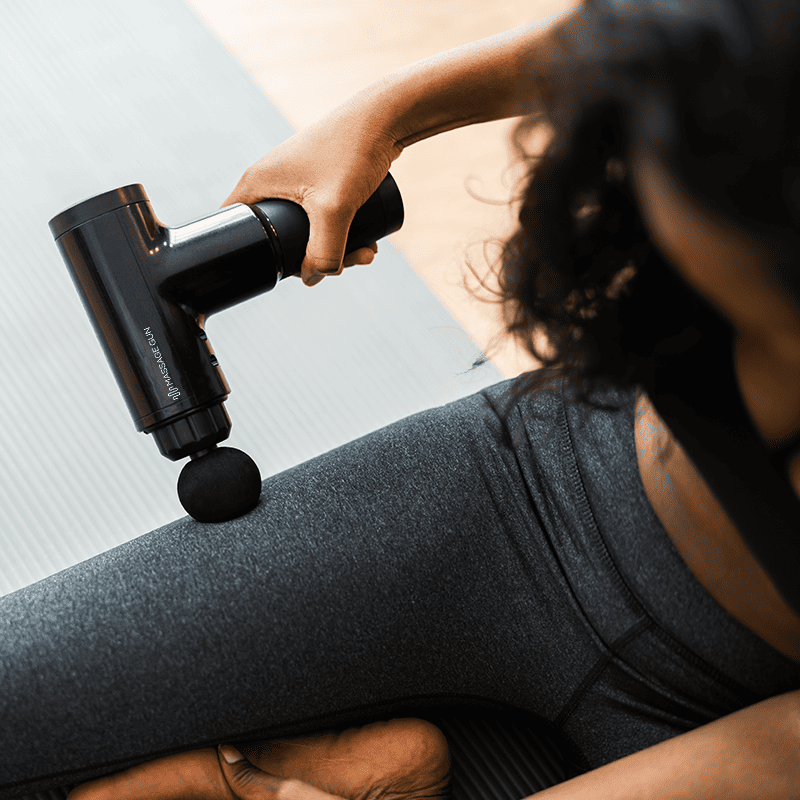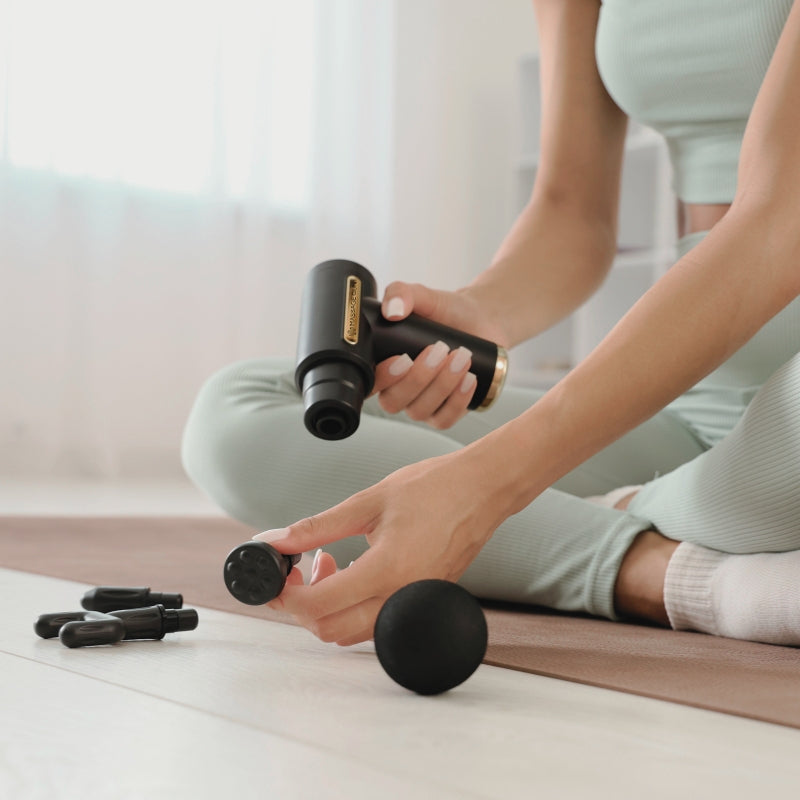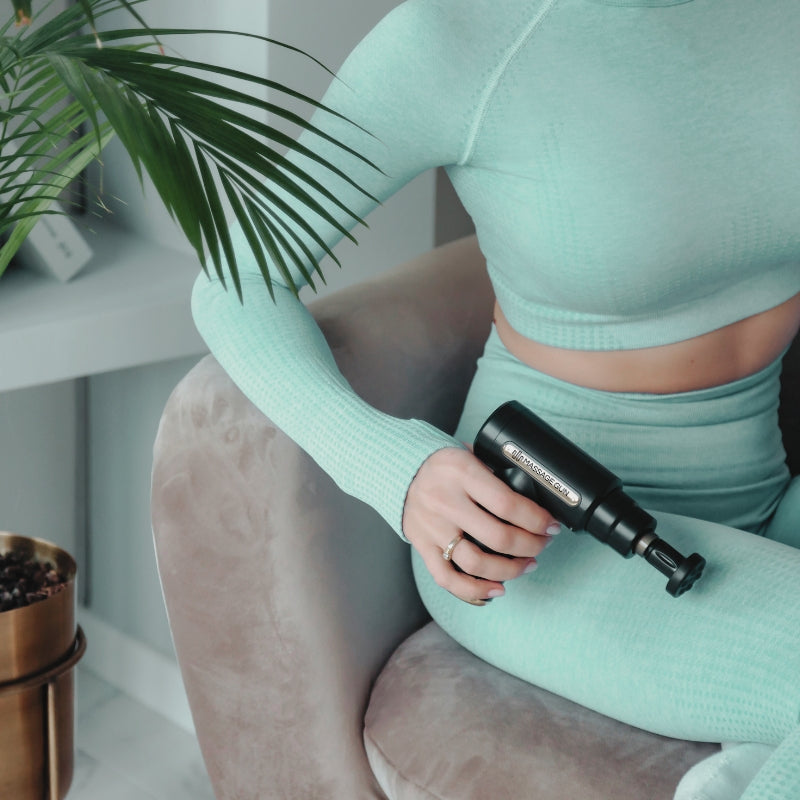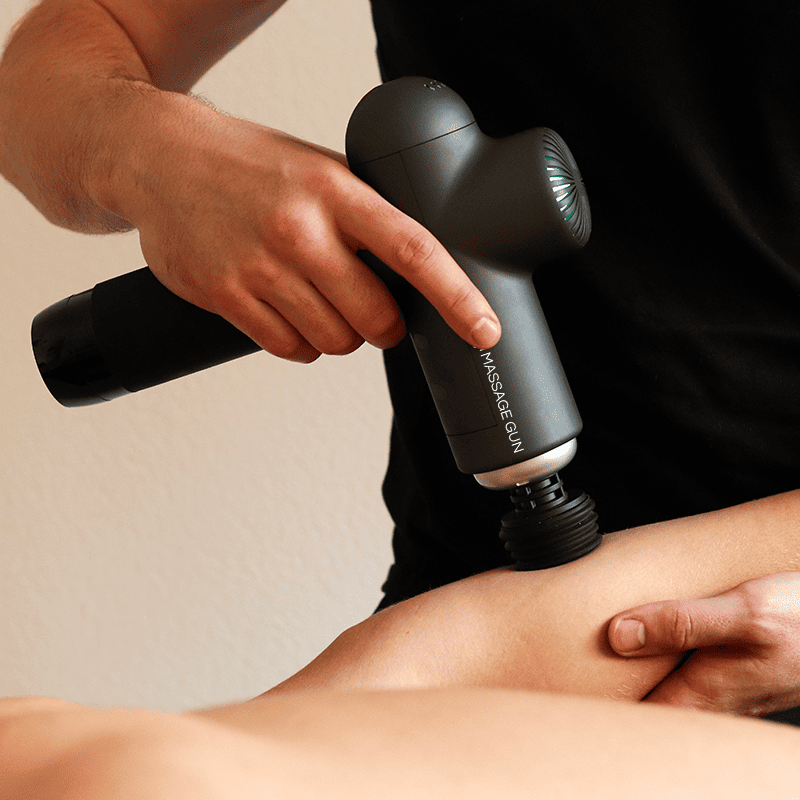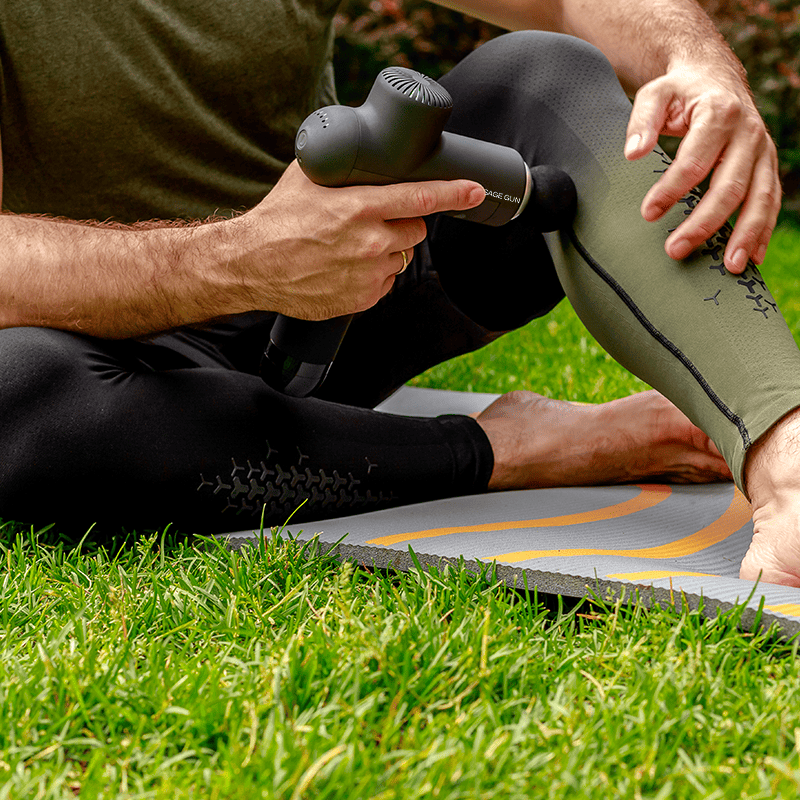Massage guns are widely used for relieving muscle tension and improving recovery, but they can cause severe injuries if misused. Knowing the correct way to handle this powerful device is crucial to avoid pain and damage to your body.
In this guide, we’ll explore where not to use a massage gun, focusing on areas prone to injury and offering advice on how to safely incorporate percussive therapy into your recovery routine.
General guidelines for safe massage gun use

Before using a massage gun, remember to start on the lowest intensity setting to avoid severe damage. Always keep the massage device moving rather than staying on one spot for too long. Overuse or high pressure can cause tissue damage, particularly to bone, tendon, or connective tissue.
This therapy is most effective when used for about one to two minutes per area, which will help improve muscle recovery and prevent pain or injury. For those experiencing soreness or tight muscles, combining the percussion tool with foam rolling can enhance results.
Critical areas to avoid using a massage gun

Neck and throat area
It is essential to avoid using a massage gun on your neck or throat. These areas contain vulnerable structures like the carotid artery and nerve roots. Applying intense pressure here can lead to nerve damage, vascular injuries, or even nerve compression.
Using a percussion massager in this area can worsen neck pain and create more severe issues, such as musculoskeletal injuries. If you need to treat this region, consult a physical therapist or use a lighter, more targeted massage device.
Spine and bony areas
Avoid using a massage gun directly on the spine or other bony areas, such as the elbow, ankle, and collarbones. The percussive force can lead to bruises, torn tendons, or even fractures.
Professional athletes and therapists often recommend targeting muscles around the spine rather than on it to prevent organ damage and spinal cord injuries. If you’re recovering from a workout or treating soreness, use foam rollers or manual massage therapy as safer alternatives for these regions.
Areas with injuries or medical conditions
Using a massage gun on areas with open wounds, bruises, or torn tendons is dangerous and can worsen your condition. Additionally, people with conditions like deep vein thrombosis (DVT) should avoid vibration therapy entirely, as increased blood flow can cause clots to move, leading to an emergency.
Always check with a doctor or physical therapist if you have any existing injuries before using this massage tool. Systematic reviews show that using a percussion massage gun incorrectly can lead to complications in patients with musculoskeletal injuries or vascular injuries.
Internal organs and sensitive areas

Sensitive areas like the abdomen, groin, and kidneys should be avoided when using a massage gun. These regions lack muscle padding and can be easily harmed by the deep tissue massage provided by the gun.
This can lead to serious internal injuries, including organ damage. Instead, focus on muscle groups far from internal organs, and if in doubt, consult a professional before using massage gun therapy in these regions.
The overlooked risks of using a massage gun on hands and feet

Why hands and feet are vulnerable?
While it may be tempting to use a massage gun on the hands or feet after a tough workout, these areas are home to many small bones and tendons that are vulnerable to injury.
Athletes or people with tight muscles often report trying to treat these areas with a massage tool, only to experience more pain or inflammation. Massage guns can cause tendon or joint damage in these regions if not used properly.
Safer alternatives for hands and feet
Instead of using a massage gun on the hands or feet, consider using gentler methods like foam rolling or a massage stick. These tools can effectively stimulate blood flow without risking painful injury.
Light, targeted massage with manual pressure can also help reduce soreness in the muscles of the hands and feet while avoiding the risks associated with percussive therapy.
When not to use a massage gun?

After recent surgeries or injections
Using a massage gun near surgical sites or recent injections can delay the healing process and cause additional pain. It’s crucial to wait until the area is fully healed before applying percussion therapy to avoid disrupting connective tissue or irritating the skin.
If you have recently undergone surgery, ask your therapist or doctor for advice on how to safely proceed with recovery treatments.
With certain medical conditions
People with certain medical conditions, such as deep vein thrombosis, osteoporosis, or chronic pain, should avoid using a massage gun without consulting a health care professional.
The vibration therapy and increased blood flow could worsen these conditions or lead to dangerous complications. Always remember to check with a physical therapist before using a massage tool if you are uncertain.
During pregnancy
During pregnancy, the abdomen and lumbar spine become sensitive areas, and using a massage gun in these regions could cause complications.
Pregnant women should avoid applying pressure to these areas, as it may result in premature contractions or harm to the baby. For safer alternatives, opt for lighter massages or stretching exercises designed to relieve muscle tension without causing harm.
Conclusion

Using a massage gun can greatly improve muscle recovery and provide effective pain relief, but only when used correctly. By avoiding the areas mentioned and incorporating safe practices, you can reduce soreness and prevent injury. Always consult a professional for guidance on proper massage gun usage, and listen to your body during every session.
Frequently asked questions

1. Can you use a massage gun on your neck?
No, it’s generally not safe to use a massage gun directly on your neck. The anatomy of the neck includes sensitive structures like blood vessels, nerves, and the spinal cord.
Using a handheld device on this area can lead to dangerous complications, including nerve damage, compression, or worsening symptoms. Instead, opt for conventional massage or consult a physical therapy professional to avoid these issues. Watch a video or read a blog for proper neck care. Always avoid percussive massage on the neck to prevent serious injury.
2. Is it safe to use a massage gun on your spine?
No, using a massage gun on your spine is not recommended. The spine is primarily made up of bones with little soft tissue around it to absorb the force. Applying pressure here could hurt you and worsen soreness or even cause irritation in your lymph nodes.
Instead, focus on massaging the muscles surrounding the spine, like the hamstrings and lower back, to promote flexibility and relieve pain. If you're active in training, a proper recovery method will help achieve mobility and enhance performance.
3. Can I use a massage gun on a bruised or injured area?
Avoid using a massage gun on bruised, injured, or sore areas like knee joints or where you have open wounds. Using the device in these instances can make things worse, as it may slow down healing and cause more irritation or even damage your blood vessels.
For these areas, consult experts or use gentler physical therapy treatments like soft tissue massage that won’t increase the risk of further harm. Always treat injuries with care to avoid exacerbating the damage.
4. Should I avoid using a massage gun on bones?
Yes, you should definitely avoid using a massage gun on bones like your knee, collarbones, and elbows. These areas don't have enough soft tissue to cushion the percussive massage, which could lead to hard sensation or even injury.
It's also crucial to avoid massaging areas where lymph nodes are present, as it can trigger negative effects. Instead, use the device to target the muscles, helping to improve strength and flexibility while avoiding the risks that come with applying pressure on bones.
5. Can you use a massage gun on your abdomen or near internal organs?
No, it’s unsafe to use a massage gun on your abdomen or near internal organs like the kidneys or liver. These areas lack soft tissue, and applying intense pressure can cause severe damage, including injury to your blood vessels. In these cases, it’s best to avoid direct percussive massage.
Instead, try relieving tension with light stretching or conventional massage techniques. Always take note that stimulating internal areas with a massage device could lead to negative consequences, so proceed with caution.
6. Is it safe to use a massage gun during pregnancy?
Using a massage gun during pregnancy, particularly on sensitive areas like the abdomen or lower back, is not advised. This is because applying percussive pressure here may trigger unwanted effects, such as discomfort or early contractions.
It’s always a good idea to consult with a healthcare professional and look for gentler alternatives, like prenatal physical therapy or massage that focuses on improving mobility and relieving tension without posing a risk to the mother or baby.
7. Can you use a massage gun on your knees or joints?
It’s best to avoid using a massage gun directly on knee joints or other joints. The knee and elbows consist mainly of bones and connective tissue, making them vulnerable to percussive massage.
For pain around the knee, focus on treating the surrounding muscles, like the hamstrings and quadriceps, to improve strength and flexibility. Doing so will help relieve pain and improve your overall mobility during training, without placing stress on the joint itself.
8. Should I use a massage gun if I have a medical condition like deep vein thrombosis (DVT)?
If you have deep vein thrombosis (DVT) or other vascular conditions, using a massage gun is unsafe. Stimulating the area with a percussive device can lead to dislodging blood clots and cause life-threatening complications.
In this instance, always seek expert medical advice before using any type of massage therapy. Focusing on safe injury prevention methods, like light physical therapy, is key to improving recovery without posing additional health risks.
9. Can I use a massage gun on the hands or feet?
While it may be tempting to use a massage gun on your hands or feet, these areas are filled with small bones and tendons, which can easily get hurt. For active individuals, use lighter settings or switch to manual massaging techniques to avoid injury.
Applying too much force can lead to worsened soreness or discomfort. It’s important to remember that these areas are delicate, and massaging them with care will help improve performance without increasing the risk of damage.
10. How long should I use a massage gun in one area?
You should limit the use of a massage gun to about 1-2 minutes per area to prevent irritation or tissue damage. Longer use in one spot can lead to negative side effects like increased pain or worsened soreness.
By stimulating the muscles in short intervals, you can improve mobility, boost oxygen-rich blood flow, and aid recovery without risking injury. Always remember to take it a bit slow and allow your body to recover between sessions.




